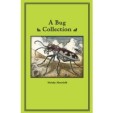A mayfly, newly aware that her lifespan is but a day, quotes Dylan Thomas to her also-dying love: “Do not go gently into that good night.”
A firefly, with something “a little off in his bioluminescence,” is all but sidelined during his companions’ spectacular nighttime light shows.
A ladybug, despite his powers to charm, is justifiably suspected of serial-killing fellow beetles.
Love and mortality, aspiration and disappointment, evil and the sometimes-futile attempts to overcome it: In her dazzling new book A Bug Collection, Melody Mansfield takes universal concerns like these and boils them down into concentrated, microcosmic packages—several stories, two poems, and one play. Though written from bugs’ points of view, all of the works offer insightful glimpses into the lights and darks of living in this world.
Discussing the book in an interview with Moorpark College’s Student Voice, Mansfield said, “It’s about depression, and disabilities, a part of love and death and what it means to be alive …. But it’s all very condensed because they are bugs and they only have just a little time ….”
The views of mortality in A Bug Collection are refreshingly multidimensional. Although death may bring an all-too-quick ending to a happy life and love, as in “Ephemeroptera,” the story of the dying mayflies, it might also offer a much-prized glimpse into the unknown, as in “Teleological Matters,” the tale of an inquisitive young pond-strider. Or it might be eerily entwined with sex and desire, as in “Mantis Prayers,” in which Gabriel, mantis and resident of a haunted graveyard, yearns for a soul mate. Eventually, he is carried (possibly by a crow) to a new land that may be Paradise, and there he seems to find his love:
And then Gabriel felt his body plunging, exploding, ecstatically torn. At last. Consummation. … Gabriel felt himself rising again, separated from his body as before, but this time in the misty starless night, and this time in a different, bloodier way. And then all the voices of the graveyard were everywhere around him, intertwining themselves into the arias and oratorios, holding him safe, cradling his severed head, weeping and whispering in hushed tones, with reverence, fear, anger, panic.
But even some of the darkest stories are lightened by humor, though occasionally sinister in nature. Leslie, the murderous ladybug and star of “Ladybug Lullabies,” makes this observation of a female he deems intelligent only because she is suspicious of him:
Not all the tales are necessarily unhappy or without hope. In “Metamorphosis,” Harry, a caterpillar who believes he may be dying, gets some words of comfort from a dung beetle and a cockroach by the name of, yes, Gregor Samsa. Near the end of the story, Harry feels “his organs breaking up …, his old sausage self-breaking down, melting into something formless and liquid. … And he slept then, enfolded in the darkness, for a minute, or for a week, or perhaps for eternity. And then, something fluttered. Harry wasn’t waking up. Not exactly. But something else was, and it was bright, and wet, and spindly, and new. And he felt the twitching of a soul—was it his?—rebuilding, unfurling, and he saw a picture, blue and orange, emerging.”
Another pleasure of A Bug Collection is its playful variation in genre, form, and style. Mansfield gives us buggy versions of everything from a hard-boiled detective yarn to a Biblical story of creation to a fresh take on Persephone’s entrapment in the underworld. She also introduces insects’ perspectives to certain literary classics, including works by Melville and Joyce. As one example, here is the opening of “Portrait of the Artist as a Young Millipede”:
Like the very bugs whose lives and trials it explores, this book brings together so much to ponder and enjoy—all in one small package.
Would My Pick be Your Pick?
If you're interested in ________, the answer may be "Yes":• Literary parodies
• Some of the darker fairy tales
• Such classics as The Metamorphosis, Moby Dick, and A Portrait of the Artist as a Young Man
• Charlotte’s Web






